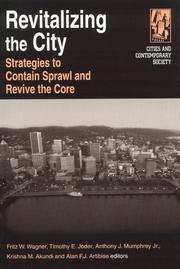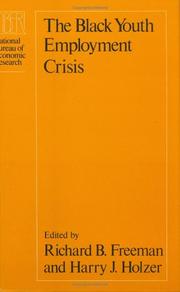| Listing 1 - 5 of 5 |
Sort by
|

ISBN: 1317460790 9781317460794 1317460782 1317460774 9780765612427 9781315701080 9781317460770 9780765612434 0765612437 1315701081 Year: 2016 Publisher: London ; New York : Routledge,
Abstract | Keywords | Export | Availability | Bookmark
 Loading...
Loading...Choose an application
- Reference Manager
- EndNote
- RefWorks (Direct export to RefWorks)
Cities and towns --- Metropolitan areas --- Inner cities --- Urban renewal --- Model cities --- Renewal, Urban --- Urban redevelopment --- Urban renewal projects --- City planning --- Land use, Urban --- Urban policy --- Central cities --- Ghettos, Inner city --- Inner city ghettos --- Inner city problems --- Zones of transitions --- Urban cores --- Conurbations --- MAs (Metropolitan areas) --- Metropolitan statistical areas --- Urban areas --- Global cities --- Municipalities --- Towns --- Urban systems --- Human settlements --- Sociology, Urban --- Growth --- E-books --- Growth.

ISBN: 9789264017320 1280173564 9786610173563 9264017321 9264017313 Year: 2004 Publisher: Paris : OECD,
Abstract | Keywords | Export | Availability | Bookmark
 Loading...
Loading...Choose an application
- Reference Manager
- EndNote
- RefWorks (Direct export to RefWorks)
This book presents a 'toolbox' of instruments for entrepreneurship development in what often appear to be the most hostile environments for economic development in our cities, showing how entrepreneurship can indeed prosper given the right stimulus. It is based on the proceedings of the conference on Entrepreneurship and Economic Development in Distressed Urban Areas held 7-8 October 2003 in Rome, and organised by the OECD LEED Programme, in collaboration with the EU, the municipality of Rome, and Risorse per Roma.
New business enterprises --- Entrepreneurship --- Inner cities --- Business incubators. --- Business hatcheries --- Experimental innovation centers (Business) --- Hatcheries, Business --- Incubator industrial parks --- Incubator space (Business) --- Incubators (Entrepreneurship) --- New business incubators --- Industrial districts --- Central cities --- Ghettos, Inner city --- Inner city ghettos --- Inner city problems --- Zones of transitions --- Cities and towns --- Urban cores --- Entrepreneur --- Intrapreneur --- Capitalism --- Business incubators --- Business starts --- Development stage enterprises --- How to start a business --- New companies --- Start-up business enterprises --- Start-up companies --- Start-ups (Business enterprises) --- Starting a business --- Startups (Business enterprises) --- Business enterprises

ISBN: 0226385078 0226385086 9786612504266 1282504266 0226385094 9780226385099 9780226385075 9780226385082 Year: 2004 Volume: *1 Publisher: Chicago : University of Chicago Press,
Abstract | Keywords | Export | Availability | Bookmark
 Loading...
Loading...Choose an application
- Reference Manager
- EndNote
- RefWorks (Direct export to RefWorks)
Downtown America was once the vibrant urban center romanticized in the Petula Clark song-a place where the lights were brighter, where people went to spend their money and forget their worries. But in the second half of the twentieth century, "downtown" became a shadow of its former self, succumbing to economic competition and commercial decline. And the death of Main Streets across the country came to be seen as sadly inexorable, like the passing of an aged loved one. Downtown America cuts beneath the archetypal story of downtown's rise and fall and offers a dynamic new story of urban development in the United States. Moving beyond conventional narratives, Alison Isenberg shows that downtown's trajectory was not dictated by inevitable free market forces or natural life-and-death cycles. Instead, it was the product of human actors-the contested creation of retailers, developers, government leaders, architects, and planners, as well as political activists, consumers, civic clubs, real estate appraisers, even postcard artists. Throughout the twentieth century, conflicts over downtown's mundane conditions-what it should look like and who should walk its streets-pointed to fundamental disagreements over American values. Isenberg reveals how the innovative efforts of these participants infused Main Street with its resonant symbolism, while still accounting for pervasive uncertainty and fears of decline. Readers of this work will find anything but a story of inevitability. Even some of the downtown's darkest moments-the Great Depression's collapse in land values, the rioting and looting of the 1960's, or abandonment and vacancy during the 1970's-illuminate how core cultural values have animated and intertwined with economic investment to reinvent the physical form and social experiences of urban commerce. Downtown America-its empty stores, revitalized marketplaces, and romanticized past-will never look quite the same again. A book that does away with our most clichéd approaches to urban studies, Downtown America will appeal to readers interested in the history of the United States and the mythology surrounding its most cherished institutions. A Choice Outstanding Academic Title. Winner of the 2005 Ellis W. Hawley Prize from the Organization of American Historians. Winner of the 2005 Lewis Mumford Prize for Best Book in American Planning History. Winner of the 2005 Historic Preservation Book Price from the University of Mary Washington Center for Historic Preservation. Named 2005 Honor Book from the New Jersey Council for the Humanities.
Cities and towns --- Central business districts --- City and town life --- Community life --- Inner cities --- Urban renewal --- City planning --- History. --- Model cities --- Renewal, Urban --- Urban redevelopment --- Urban renewal projects --- Central cities --- Ghettos, Inner city --- Inner city ghettos --- Inner city problems --- Zones of transitions --- Activities districts, Central --- Business districts, Central --- CBDs (Central business districts) --- Centers, City (Central business districts) --- Central activities districts --- City centers (Central business districts) --- City centres (Central business districts) --- Districts, Central activities --- Districts, Central business --- Districts, Downtown --- Downtown districts --- Downtowns --- Land use, Urban --- Urban policy --- Urban cores --- Associations, institutions, etc. --- Human ecology --- Retail trade --- History --- E-books --- United States --- Sociology of environment --- History of North America --- anno 1900-1999 --- downtown, city, urban, shopping, tourism, development, commerce, decline, main street, economics, competition, retail, government, architecture, civic clubs, real estate, streets, nonfiction, history, planning, great depression, land values, politics, looting, riots, activism, abandonment, vacancy, nostalgia, inner cities, renewal, central business districts, race, racism, suburbs, gender, postcards. --- United States of America
Book
ISBN: 1282646419 9786612646416 0226560147 Year: 2008 Publisher: Chicago : University of Chicago Press,
Abstract | Keywords | Export | Availability | Bookmark
 Loading...
Loading...Choose an application
- Reference Manager
- EndNote
- RefWorks (Direct export to RefWorks)
Contesting claims that postwar American liberalism retreated from fights against unemployment and economic inequality, The Problem of Jobs reveals that such efforts did not collapse after the New Deal but instead began to flourish at the local, rather than the national, level.With a focus on Philadelphia, this volume illuminates the central role of these local political and policy struggles in shaping the fortunes of city and citizen alike. In the process, it tells the remarkable story of how Philadelphia's policymakers and community activists energetically worked to c
Manpower policy --- Job creation --- History --- Philadelphia (Pa.) --- Politics and government --- employment, postwar, liberalism, unemployment, economic inequality, poverty, labor, new deal, policy, local government, state, philadelphia, urban, community activism, deindustrialization, affirmative action, business development, inner city, training programs, job retention, race, systemic racism, intervention, regulation, legislation, nonfiction, economics, history, manpower, planning, civil rights, oic, racial conflict, model cities.

ISBN: 0226261646 9786611430948 1281430943 0226261824 9780226261829 9780226261645 9781281430946 Year: 1986 Publisher: Chicago : University of Chicago Press,
Abstract | Keywords | Export | Availability | Bookmark
 Loading...
Loading...Choose an application
- Reference Manager
- EndNote
- RefWorks (Direct export to RefWorks)
In recent years, the earnings of young blacks have risen substantially relative to those of young whites, but their rates of joblessness have also risen to crisis levels. The papers in this volume, drawing on the results of a groundbreaking survey conducted by the National Bureau of Economic Research, analyze the history, causes, and features of this crisis. The findings they report and conclusions they reach revise accepted explanations of black youth unemployment. The contributors identify primary determinants on both the demand and supply sides of the market and provide new information on important aspects of the problem, such as drug use, crime, economic incentives, and attitudes among the unemployed. Their studies reveal that, contrary to popular assumptions, no single factor is the predominant cause of black youth employment problems. They show, among other significant factors, that where female employment is high, black youth employment is low; that even in areas where there are many jobs, black youths get relatively few of them; that the perceived risks and rewards of crime affect decisions to work or to engage in illegal activity; and that churchgoing and aspirations affect the success of black youths in finding employment. Altogether, these papers illuminate a broad range of economic and social factors which must be understood by policymakers before the black youth employment crisis can be successfully addressed.
Labour market --- United States --- Afro-American youth --- Unemployment --- Employment --- African American youth --- Joblessness --- Negro youth --- Youth, African American --- Employment (Economic theory) --- Full employment policies --- Labor supply --- Manpower policy --- Right to labor --- Underemployment --- Youth --- Black young persons --- E-books --- Afro-American youth - Employment - Congresses. --- Unemployment - United States - Congresses. --- joblessness, unemployment, black youth, race, racism, discrimination, bias, labor market, career, wages, earnings, success, women, gender, attitude, economic incentives, crime, drug use, criminal activity, gang, perception, stereotypes, stigma, illegal, aspiration, ambition, churchgoing, religion, spirituality, nonfiction, economics, african american, employment, duration, job search, discharges, layoffs, transition, welfare, ghetto, poverty, inner city. --- United States of America
| Listing 1 - 5 of 5 |
Sort by
|

 Search
Search Feedback
Feedback About UniCat
About UniCat  Help
Help News
News